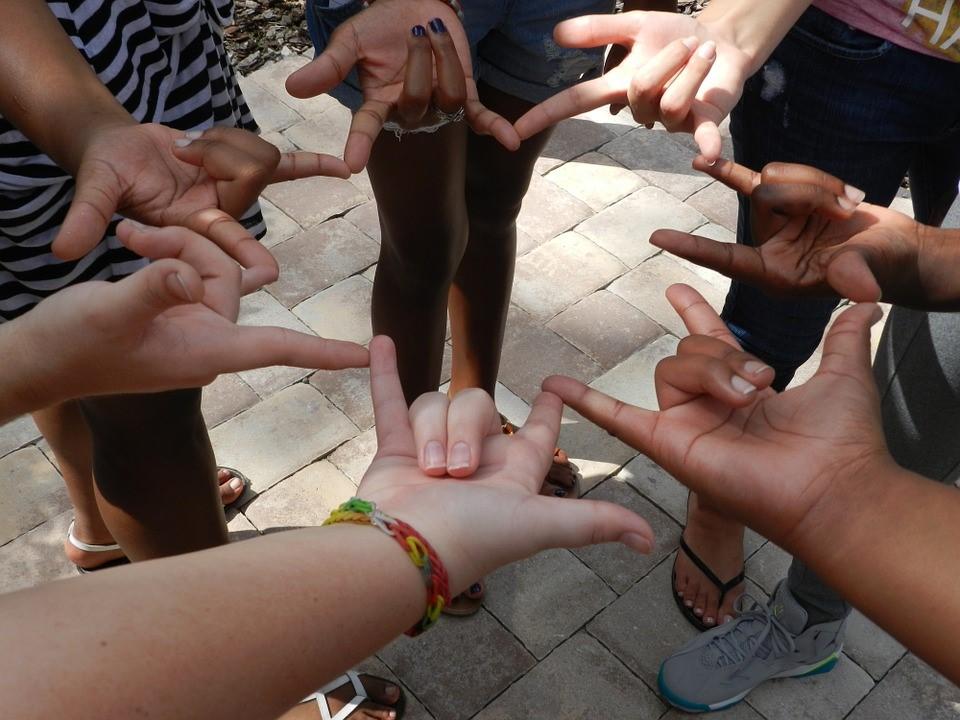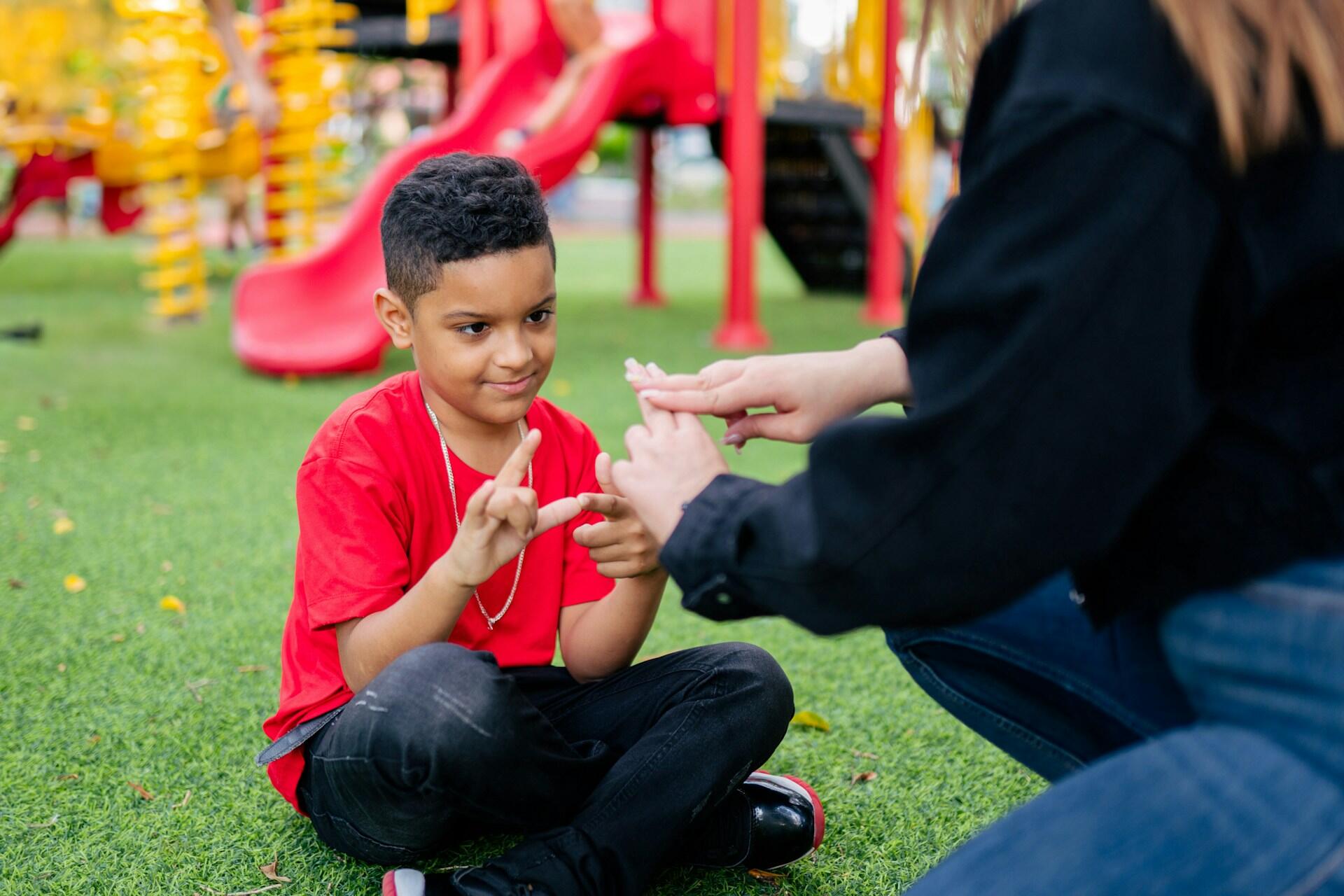The American Sign Language is a comprehensive and natural language with similar linguistic properties as other spoken languages, with a completely different grammar from English.
ASL is conveyed through the movements of face and hands, and it is the primary language of all the deaf and hard-of-hearing North Americans. However, it is also used by many hearing people as well.
A single person or committee did not invent ASL.
The precise start of ASL is unclear; however, many suggest that it started more than two hundred years ago by intermixing the French Sign Language and local sign languages.
Thus, American Sign Language today includes various LSF and local sign language elements.
Over time, these languages have changed and melded to form a complex, mature, and rich vocabulary.

The modern LSF and modern ASL are entirely different languages. And even though they both have similar signs, they are no longer understood easily by users.
There are many languages taught in US schools, and American sign language is one of them.
Even though it is not a spoken language, it has gained significant recognition and is used by most perfectly speaking US citizens.

13 Benefits Of Learning American Sign Language
ASL has been the leading means to communicate for the deaf since the early 1800s when Thomas Hopkins Gallaudet helped develop this language and later established a university exclusively for the deaf.
Teaching hearing children sign language in high school has become common.
That is why American Sign Language is now classified among the world's languages, like French, Spanish, or other foreign languages.
So, if a child or high school student speaks sign language, they are thought of as bilingual.
When high school students learn ASL and English together, they learn to process these languages via both sides of their brain.
This helps them recall the language from two places instead of relying on one.
According to research, using signs and fingerspelling accommodates a broad range of learning styles, such as kinesthetic, interpersonal, and verbal-linguistic.
Let's discuss the various benefits of learning ASL.
1. A Good Workout For The Brain
Learning a new language in high school will stimulate your brain and is also an excellent workout for your brain. And learning American sign language is no different!
Learning ASL in high school will improve your creative thinking, cognition, memory, brain functionality, mental rotation skills, spatial awareness, and more.
And just like learning to ride a bicycle, you will remember it always.
2. Introduction To The Deaf Community And Culture
When learning a foreign language in the US, you will also learn more about that country, its culture, and the people who speak that language. It all is essentially a byproduct of learning a new language.
It is similar to learning American sign language in high school since the Deaf community and culture have a rich history.
American sign language has deep roots in the Deaf culture and community. Studying ASL promotes sensitivity and better awareness towards the hard of hearing and the deaf community.
As someone proficient in high school American sign language, you will greatly appreciate the deaf culture. You can further promote acceptance and understanding of this language, among others.

3. It Is All Around Us
It is nearly impossible and difficult to understand how many individuals communicate in their local sign language.
However, just because you cannot see it does not mean it does not happen. Conversations in American sign language are happening all around us all the time.
In a report by Modern Language Association, ASL is the third-highest studied foreign language at high schools, colleges, and universities in the United States.
Popularity wise it is only second to English and Spanish in the US. You might never have thought about sign language giving competition to widely spoken languages of the world, but it does.
4. Gaining New Career Opportunities
One of the most exciting career paths for bilingual hearing professionals is becoming an interpreter.
There is an increasing need for qualified American sign language interpreters in mainstream educational institutions and the community.
Some other places with a high demand for interpreters include courts, community activities, hospitals, governmental agencies, local, state, and county legislatures.
Similarly, professionals in private and public agencies and in educational settings like counselors, teachers, therapists, specialists, and consultants, use ASL to serve hard of hearing and deaf individuals.
Emergency response workers and law enforcement also benefit from ASL knowledge.
Hard of hearing or deaf individuals proficient in American sign language might be interested in becoming ASL teachers.
The qualified ASL teachers have been certified by the American Sign Language Teachers Association (ASLTA).

5. Helps Communicate
One of the advantages of learning American sign language in high school is that it increases your communication skills.
It is one of the most widely used languages in the US and among the leading language studies in the US. Furthermore, it is recognized by around 35 states as a modern language for public schools.
There are around 250,000 to 500,000 ASL users in the US and Canada, and most of them use American sign language as their primary language. Furthermore, it is also used by:
- Deaf parents' hearing children
- Relatives or siblings of the deaf
- Hearing adults turning deaf and ones who are learning from the other deaf people
- An increasing population of second language students learning it is an elementary, primary, and high school
6. It Is A Beautiful Language
We are drawn to many foreign languages, such as Italian, due to their beauty and the emotional response they evoke.
Even though it might not seem as vital as the other benefits of the language listed, it is true with ASL.
It is a visual language and has its semantics and grammatical rules. ASL is unique since its beauty, unlike various spoken languages, is observed and not heard.
7. Make New Friends And Meet People
Being involved with various individuals in the deaf community will help you form meaningful new relationships.
When you learn American sign language with others, you will get to know each other and learn together, both offline and online.
Most offline and online workshops and courses have a community with a social media presence to share your journey and experiences.
8. Increases Reaction Time And Peripheral Vision
A University of Sheffield study shows that sign language users have enhanced reaction time and peripheral vision.
Since it is entirely visual focused, you become more alert, and the visual field response benefits from this, which is quite beneficial for many sports and driving.
The same scientists have observed that deaf people carry excellent visual abilities, which hearing adults do not.
When you speak in sign language, it is about observing hand gestures and lip reading, facial expressions, and observing one's body language.
However, you cannot watch all of it simultaneously, which is why your peripheral vision is of importance and must be exercised frequently.
9. Improves Communication With Animals
You read it right, communication with animals!
Let us clarify what this means. First, it does not entail conversing with the animals or teaching them sign language.
Not everyone realizes it, but animals can be deaf as well, and of course, they are not going to tell you that.
However, there have been many cases of success of people teaching their dogs' primary sign languages while building a bond with them.
10. Improves Communicating With Babies
You cannot expect babies to start talking to you off the bat. However, it is easier to communicate with them via sign language.
And it is not about rambling about politics or whose turn it is to take the trash out.
But it is about understanding certain basic signs for everyday concepts and objects such as 'milk,' 'sleepy,' 'hungry,' 'play,' 'more,' 'teddy bear,' etc.
Infants from the age of six months can understand basic signs.
Research shows that displaying basic signs to hearing babies can increase their cognitive development, lead to a more positive, richer interaction, and form a bond between the child and parent.
Most scientists believe that learning various languages at a younger age will help their brain make room for more language.
11. Becoming Better At Spelling
Do you know that you can become better at spelling when you learn American sign language?
There is a sign for almost every word, and for those that do not have a word, you will have to fingerspell it.
Similarly, when you are introduced to a new name, be it a location, person, brand, or product, you will need to spell it out if you don't know the sign for it.
But knowing the spelling is beneficial as you will have to fingerspell the words or write it down at the very least.
12. Becoming A Better Listener
To speak in American sign language, you must entirely focus and concentrate on the speaker. Of course, eye contact is essential, but you cannot sign words without looking at them physically.
And it is not only about the hand gestures, but it is also to focus on body movements and facial expressions that carry as much importance in sign language as hands.
Focusing on the speaker constantly speaking to you in sign language will make you a better listener.
Because when you speak orally, looking somewhere else is easy, like using the phone while speaking or having your back to them, among others.
13. Diversifying
Most businesses say they are diverse and inclusive but are they really?
When you know sign language, you will connect and reach the deaf community, preparing you to handle the communication and language barriers.
It is cliché, but American sign language will help your workplace, and you diversify.
American Sign Language Taught In High School
ASL is one of the most prevalent foreign languages taught in US schools.
If you want to start learning American sign language or a foreign language like German during or after high school but do not know where to start, why not contact Superprof?
Superprof has hundreds of American sign language tutors near you who are experienced, certified, and are ready to help you study the language.










